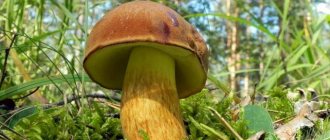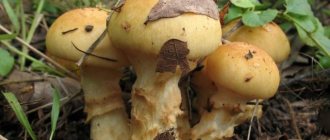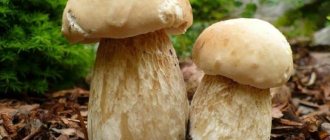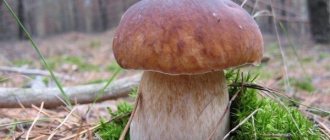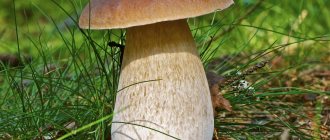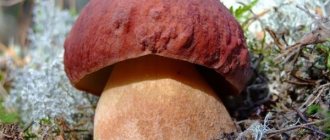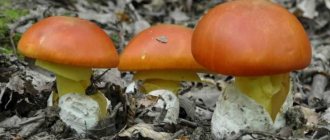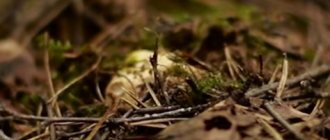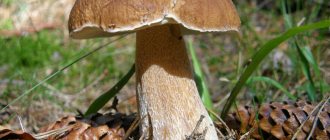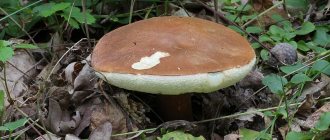The semi-white mushroom or, as it is also called, the yellow boletus (Boletus impolitus) belongs to the Boletaceae family. In some areas of our homeland it is called lemongrass (lemon). Genus: boletus. We have known about this mushroom since childhood, since there are a lot of references to boletus mushrooms in Russian literature. However, this mushroom has a more common name in science and is called semi-white.
There are many boletus species, but it is the semi-white species that deserves special consideration. It has nutritional qualities and properties that no other mushroom in the family can boast of. Let's find out what exactly we are talking about.
Description
The semi-white mushroom has a cap from 6 to 21 cm. At the beginning, in young boletes, it is convex, and over time it becomes cushion-shaped or prostrate. The skin on the cap can be smooth or velvety.
Its color is:
- clay-ocher;
- light gray;
- brown.
The tubular layer has the following tones:
- lemon yellow;
- golden yellow;
- yellow-green.
The leg has a height of 6 to 10 cm and a diameter of 3.5 to 6 cm. Its upper part is yellow, the base is dark brown, and sometimes has a red belt. The appearance of the leg is squat, tuberous-swollen, and over time it becomes rough, cylindrical or fibrous.
Did you know? Mushrooms are much older than dinosaurs; scientists agree that boletes have been living on the planet for 400 million years. Of the existing species, only ferns can boast of the same age. Moreover, unlike them, which were quite crushed, the modern mushroom is practically no different from its ancestor.
The pulp is quite thick and has a bright yellow tint. When cut, the color remains virtually unchanged. In rare cases, in overripe representatives, the flesh may turn slightly pink or blue, but not immediately, but within half an hour. The raw mushroom tastes slightly sweet, its smell gives off carbolic acid.
Primary processing and cooking recipes
Having collected mushrooms in the forest, they need to be processed on the same day. Be sure to clear forest debris, remove wormy places and throw away rotten fruits. Then soak for at least 1 hour to remove the bitterness.
Cooking
The semi-white mushroom should be cooked for at least 30 minutes in salted water. After this, it can be fried, pickled and frozen.
Pickling method
It is the pickled semi-white mushroom that is considered the most delicious. To prepare you will need to take:
- boletus - 1 kg;
- water – 0.5 l;
- vinegar – 100 ml;
- onion – 150 g;
- sugar – 1 tbsp. l.;
- salt – 2 tbsp. l.;
- laurel leaf – 1 pc.;
- cloves – 3 pcs.;
- peppercorns – 5 pcs.
How to marinate:
- Mushrooms are boiled with laurel leaves and pepper for half an hour.
- Remove the fruits and add salt, sugar, and cloves to the broth.
- After the mixture boils, pour in the vinegar and add the fruit.
- After 15 minutes, remove from heat.
- Line the bottom of the jars with onions, then arrange the mushrooms and pour boiling marinade over everything.
Store closed jars in the refrigerator on the bottom shelf.
Frying
Fried mushrooms are easy to prepare; for this you will need:
- boletus - 500 g;
- onion – 200 g;
- vegetable oil – 50 ml;
- salt, pepper to taste.
How to cook semi-white mushroom:
- The onion is finely chopped and fried in a frying pan over low heat with the addition of vegetable oil until it becomes transparent.
- Pre-boiled mushrooms are cut into equal pieces and added to the pan.
- After 10 minutes, add salt and pepper to the mixture. Fry for at least 15 minutes.
These fried mushrooms are best served with boiled potatoes.
Salting for the winter
To prepare you will need:
- lemon boletus – 1 kg;
- garlic – 10 cloves;
- salt – 200 g;
- horseradish - 2 leaves;
- peppercorns – 5 pcs.;
- allspice – 5 pcs.;
- dill - 5 umbrellas;
- vegetable oil – 1 tbsp. l.
Salting process:
- Mushrooms must be pre-soaked and boiled. Cut them into small pieces.
- The bottom of the prepared jar is lined with horseradish leaves.
- Add half of all ingredients (except oil) and a pinch of salt.
- Lay out the boletus mushrooms in layers, sprinkling each with salt.
- Place the remaining garlic, pepper and dill in the middle of the bottle.
- Continue alternating mushrooms and salt until the end of the fruit.
- There should be about 3 cm of free space at the top. Cover with a horseradish leaf and sprinkle with salt.
- Pour the oil over the leaves. Cover with a lid and place in a cool place for 15 days.
Drying
To dry the semi-white boletus, you will need an oven, because they will take quite a long time to dry outside. If the harvest is harvested in the summer and the weather is hot, then you can string the fruits on a thread, cover with gauze and dry in the sun in a well-ventilated place.
Important! Before drying, the mushroom is not soaked, washed or boiled.
It is enough to clear the fruits of debris and remove spoiled areas. Boletus mushrooms are cut into equal pieces so that the process proceeds evenly. Dry them at a temperature of 50 degrees with the oven door slightly open. Ready mushrooms are soft to the touch, elastic, do not release liquid and do not crumble into dust.
Edibility
According to experienced mushroom pickers, this type of mushroom is considered one of the most delicious. According to the official classification of mushrooms, half-white mushrooms belong to category No. 2. But in some sources you can find information according to which hemileccinum impolitum is considered conditionally edible.
Did you know? Despite the fact that when dried, 80% of the water is removed from mushrooms, they still remain a fairly high-calorie product, since the amount of protein in them ranges from 0.9 to 3.3%.
This is due to the specific smell that is released when the plant is collected. Although when boiled, all unpleasant discharge disappears. Prolonged drying also helps in the fight against aroma.
Growing at home and in the country
Boletus mushrooms are very popular, and therefore they are increasingly grown in household plots. To do this, it is enough to bring overripe fruits from the forest, soak them for a day in water, which is then poured onto the ground under the selected tree. The harvest can be harvested after at least 2 years.
You can also bring mycelium from the forest. When digging, you need to make a depression of at least 15 cm, with a radius of up to 30 cm. Such prey should be carried very carefully. In the garden, mycelium is planted in the chosen place to a depth of no more than 7 cm, then it must be well watered and covered with foliage.
Important! The place for planting forest fruits should be shaded.
Application
Yellow boletuses, like all edible mushrooms, have a certain amount of useful substances.
Important! The yellow boletus itself does not have any substances that have a harmful effect on the human body. But do not forget that boletes draw toxic contents from the soil. Therefore, these plants should be collected away from hazardous industries and highways.
By eating this impolitus, you can compensate for the deficiency in the body:
- B vitamins;
- amino acids;
- zinc;
- proteins that are easily digestible.
The use of the semi-white mushroom helps people put their nervous system in order, improve the condition of their hair and skin, and also has a beneficial effect on the endocrine system.
In cooking
This species has excellent taste and tender flesh.
You will be interested to know how to deliciously prepare creamy porcini mushroom soup.
Like all boletus, yellow boletus can be prepared in different ways:
- marinate;
- salt;
- cook;
- bake;
- dry.
According to culinary specialists, pickled semi-white mushroom is no different from its white counterpart. These boletes are used in the preparation of main dishes and as a side dish. They are fried with potatoes and meat, added to salads, but the most popular dish is the soup made from this representative of the mushroom kingdom. Descriptions of detailed recipes can be easily found on the Internet.
In medicine
Even in ancient times, people knew about the beneficial medicinal properties of this plant species. They were used for tinctures and broths. To this day, books on folk medicine describe various recipes using the semi-white mushroom, which is mainly used as a sedative.
Important! There are inedible look-alikes. They are called inedible boletus and root boletus. They have a lighter color, unlike the semi-white mushroom, and a sour taste. The cut of these boletes is dark blue.
According to official medical sources, these diseases are:
- prevent cancer;
- improve the functioning of the immune system;
- treat viral diseases;
- improves brain function.
In cosmetology, this type is used for compresses that improve skin and hair.
Where do yellow boletus grow?
Boletus is an incredibly tasty mushroom, and also very healthy. Based on it, you can make various decoctions and other traditional medicine recipes that will certainly be useful to you in treatment.
However, this mushroom is still highly valued for its pleasant taste and aroma. Pickled boletus has received special love, which will delight you at any time of the year.
So, in order to find boletus, you need to know when to search. We recommend that you go on a quiet hunt between July and October.
This mushroom loves shady forests and moist soils. Therefore, the ideal place for its existence is mixed or deciduous forests, where beech and oak predominate.
Most often, this mushroom is found in Western Europe, however, it is also incredibly easy to find in the western part of Russia.
In our country, the yellow boletus is most widespread in Europe, as well as in the Ussuri region and in the Sochi Nature Reserve.
The mushroom harvest itself occurs in autumn, if it was warm. Then the collection takes place in October, and sometimes even in November. However, if the autumn turned out to be cold, then it is recommended to collect this mushroom no earlier than in early November.
The semi-white mushroom is on Wikipedia.
False doubles
Like all mushrooms, hemileccinum impolitum has twins. The most similar of them is the maiden boletus; it differs from the yellow boletus only in its darker top and cone-shaped leg. Also, the semi-white boletus looks like a green moss. This twin can be identified by its thinner stem and large pores.
Naturally, we should not forget that the semi-white mushroom is similar to its white older brother and differs from it in a more yellow color. Hemileccinum impolitum is a worthy representative of the mushroom kingdom. Despite the fact that this species is rare in our region, it has beneficial and nutritional properties. The semi-white bolet can decorate the basket of any “quiet hunter”.
Time and place of fruiting
The semi-white mushroom or yellow moss mushroom prefers damp areas and is found in floodplains of oak, hornbeam and beech forests, and extremely rarely under coniferous trees. Loves clayey, moist soils.
Chooses warm places, can be found in the forests and forest-steppes of Europe, Polesie and the Carpathian region, in Russia in the center and south of the European part. In Kuban it can be found in the foothills and mountain zones, on the border with other regions.
Fruiting time is from May to the beginning of winter. It does not occur every year, but if it grows, it grows abundantly.
Video
Related species
The semi-white mushroom has long belonged to the boletus or boletus genus. The genus is quite numerous and includes about 300 species, among which there are both edible, conditionally edible, and inedible (non-toxic), toxic and poisonous. Therefore, we can say that the semi-white mushroom has many relatives.
Edible species include:
- maiden boletus (brown-yellow boletus) – Boletus appendiculatus;
- bicolor boletus – Boletus bicolor;
- Burroughs boletus – Boletus barrowsii;
- Fechtner's boletus – Boletus fechtneri;
- yellow boletus (yellow boletus) – Boletus junquilleus and others.
The group of inedible, toxic and poisonous species includes:
- beautiful boletus (beautiful boletus) – Boletus calopus – inedible;
- Boletus porosporus (Boletus porosporus) – inedible;
- purple boletus (pink-purple boletus) – Boletus purpureus – inedible;
- legal boletus – Boletus legaliae – toxic;
- beautiful boletus - Boletus pulcherrimus - toxic;
- satanic mushroom – Boletus satanas – toxic, etc.
Giant mushroom sparassis curly
A huge curly sparassis grows on the roots of coniferous trees. By its nature, it is a parasitic fungus, since it destroys the tree, causing red rot disease, which leads to the death of the host. The weight of one adult mushroom can reach 10 kg, and the width can be more than 0.5 m.
It grows in a dense bush, which is formed, in principle, by small mushrooms with wavy, curved caps, their diameter does not exceed 5 cm. The mushroom bush has a round shape and is very curly, which is why it got its name. It is also often called cabbage (mushroom, hog cabbage, or hare cabbage). The mushroom is edible: the young, fragile pulp is very tasty and smells like nuts, but in old sparassis it becomes tough.
Mushroom cabbage is protected by the Red Book, as it is on the verge of extinction.
How to distinguish edible from inedible
If you are not yet an experienced mushroom picker enough to recognize the boletus mushroom, a photo and description of this mushroom should always be at hand. Most often, boletus is confused with porcini mushroom. The semi-white mushroom differs from this close relative in the smell and color of the pulp.
There is also a possibility of confusing boletus with deep-rooting boletus. The difference between this mushroom is the color of the cap, it is light gray, and also the color of the legs and pores - lemon yellow. This mushroom is inedible; when pressed, the flesh turns blue. In addition, deep-rooted bolete has a pronounced bitterness, and it is very difficult not to notice it.
Due to their yellow flesh, boletus mushrooms in some regions are called jaundice mushrooms (photos and descriptions of these mushrooms have many differences), but in fact, these are completely different mushrooms.
Danger of use
The half-white boletus is not poisonous. However, when using it, you should follow some rules:
- Don't eat too many mushrooms.
- It is best to eat bolet at lunch or in the evening, but no later than a few hours before bedtime.
- Try to combine mushrooms with a variety of side dishes. Eating large amounts of “pure” mushrooms can cause severe heartburn.
You should avoid consuming yellow boletus mushrooms in the following cases:
Age up to 10 years. Children's digestive system is not yet fully developed. Eating yellow boletus, especially in large quantities, can lead to colic, abdominal pain, and belching. The mushroom contains a large amount of fiber, which is not very suitable for a child’s stomach. The semi-white bolete contains disaccharides
In this regard, people with diabetes mellitus type 1 or 2 should eat it with extreme caution. And it is best to completely exclude the semi-white mushroom from your diet. Also, people who have serious kidney problems should not eat mushrooms. This is due to the fact that such products may contain an increased concentration of nitrates.
In addition, do not forget that the semi-white boletus, as well as other mushrooms, is capable of absorbing various toxins and other harmful substances from the soil and air. So you should not collect them in close proximity to highways and other polluted places.
Is it possible to eat it?
The semi-white mushroom is edible. Moreover, it is very tasty. It can be safely boiled, fried, pickled and dried. All preparations are good in their own way. After heat treatment, the specific iodine smell disappears, and the pickled mushrooms turn out simply excellent.
Yellow bolet can be frozen for the winter. First of all, the mushrooms are soaked and after a few hours they are cleaned of dirt and soil. Then they are thoroughly washed, cut into pieces, placed in boiling water and cooked until tender in salted water. Next, the mushrooms must be discarded in a colander to drain excess moisture. Pack into bags and place in the freezer.
Red Book mushroom hericium coral
Among the unusual edible mushrooms, there is one species that can never be confused with others. Its kind simply does not exist in nature - it is coral hericium. The mushroom body is simply a huge branched bush with many straight or curved thorns. Most often the bush is white, but it can also be cream. Not everyone manages to come across hericium coral, because it is a very rare mushroom. In Russia, it grows mainly in the Far East, Krasnodar Territory, and Siberia. It grows on trees and stumps, only on deciduous trees. Young, aromatic and elastic flesh is white, less often pinkish or yellowish, smells pleasant and is very tasty, but old mushrooms become tough.
Coral mushroom, as hericium is also called, has other names based on its shape. So, among mushroom pickers it is known as the lattice-shaped hedgehog or the branched hericium.
Beautiful saprophyte Sarcoscypha scarlet
In early spring, in almost all countries and contingents, entire families of Sarcoscypha scarlet grow on fallen trees. A deeply concave cap is attached to a low whitish stem; its shape is more like a bowl. The inside is bright red, while the outer “walls” have a lighter shade. Some mushroom pickers claim that the pleasant-smelling, elastic pulp of sarcosciphy is quite edible, but most still avoid these mushrooms because they are too small, and also quite tough.
Due to its concave cap and bright color, the mushroom is also called the scarlet elf cup. It is noteworthy that it grows only in ecologically clean areas, avoiding forest belts near large roads and cities, where the air is polluted with all sorts of emissions.
Collection rules
It is best to go to the forest for the semi-white boletus in mid-August. From this time until mid-autumn, the mushroom bears fruit most actively. The most rapid growth of fruiting bodies usually occurs after rainy days.
You need to choose clean forests for collection, located away from industrial facilities and major roads. Since mushroom pulp quickly accumulates toxic substances, fruiting bodies grown in contaminated areas can be hazardous to health. It is better to collect young semi-white bolets; they are denser in structure, pleasant in taste and also contain a minimum of toxic substances from the air and soil in their pulp.
Advice! In order not to cause damage to the mycelium of the semi-white boleta, you need to twist it out of the ground using rotational movements by the leg. You can also use a sharp knife, but you shouldn’t just pull out the fruiting body - this destroys the underground part of the boletus.
